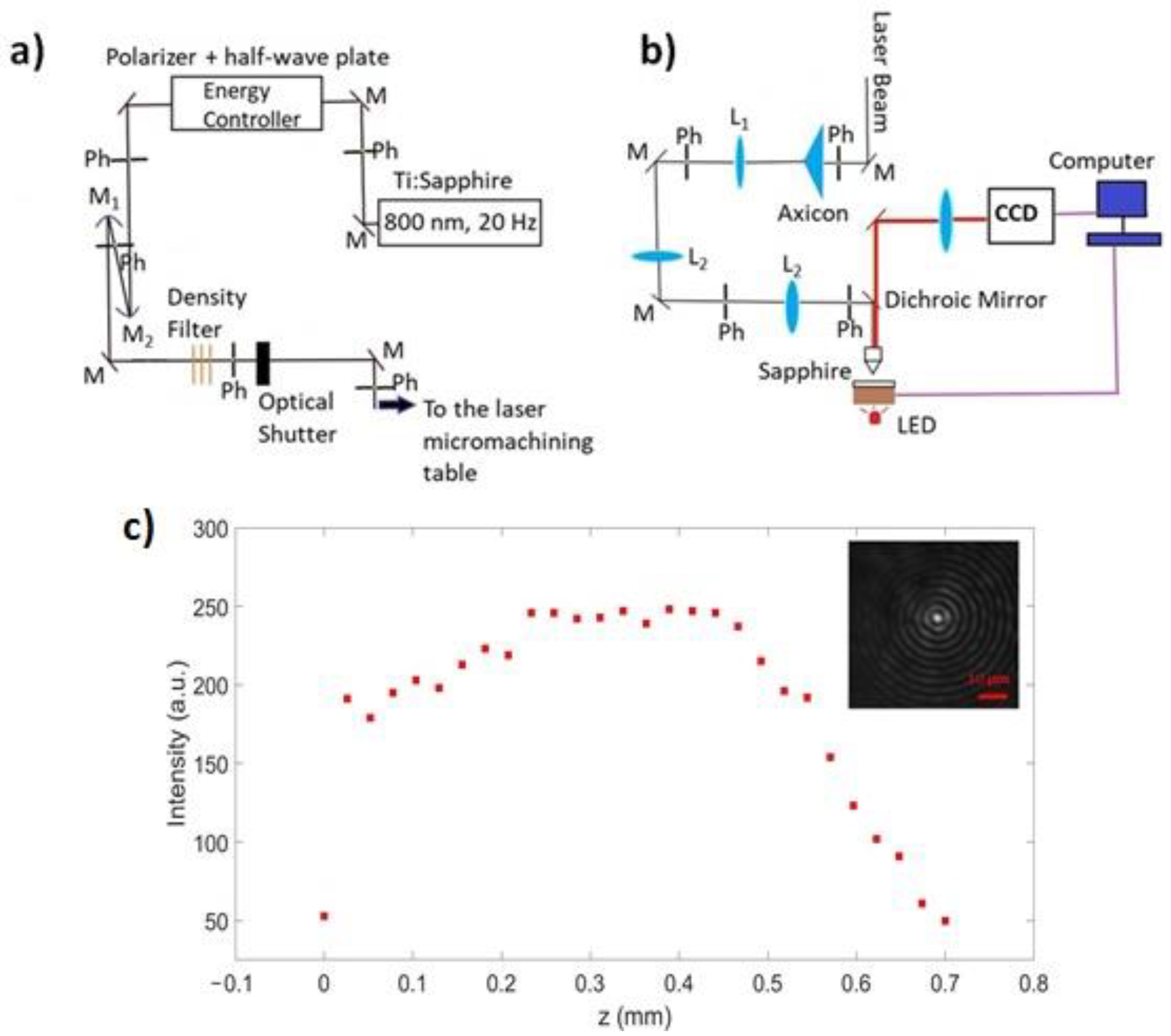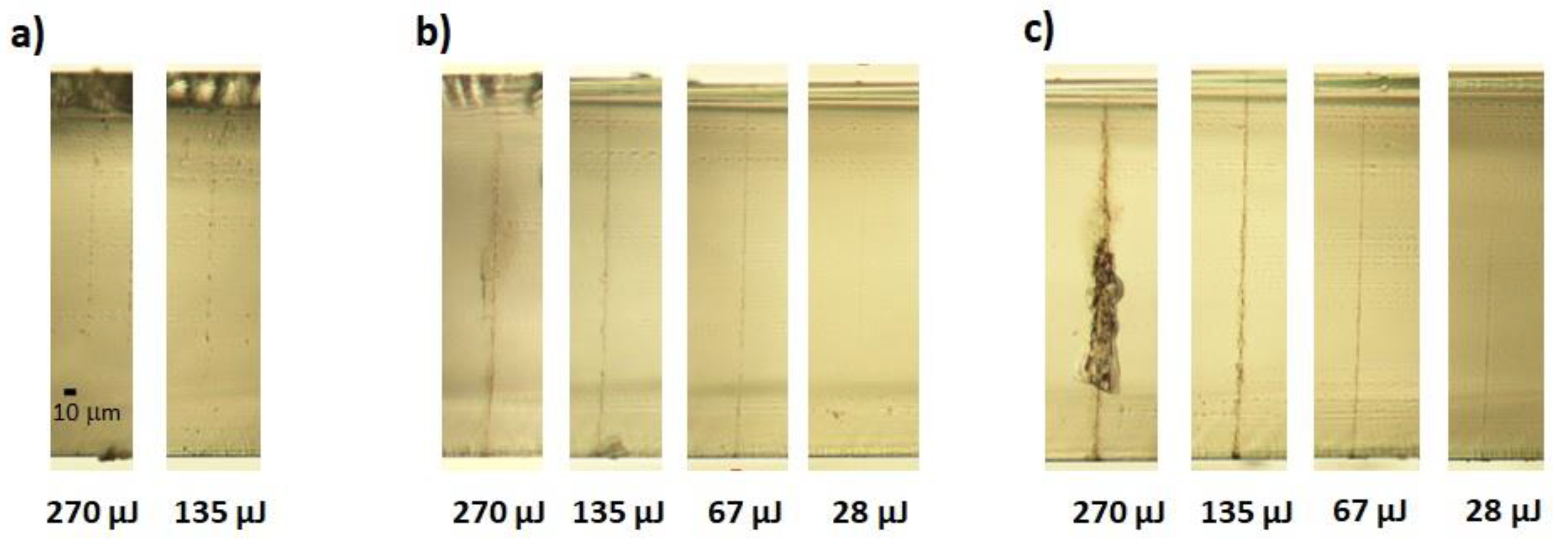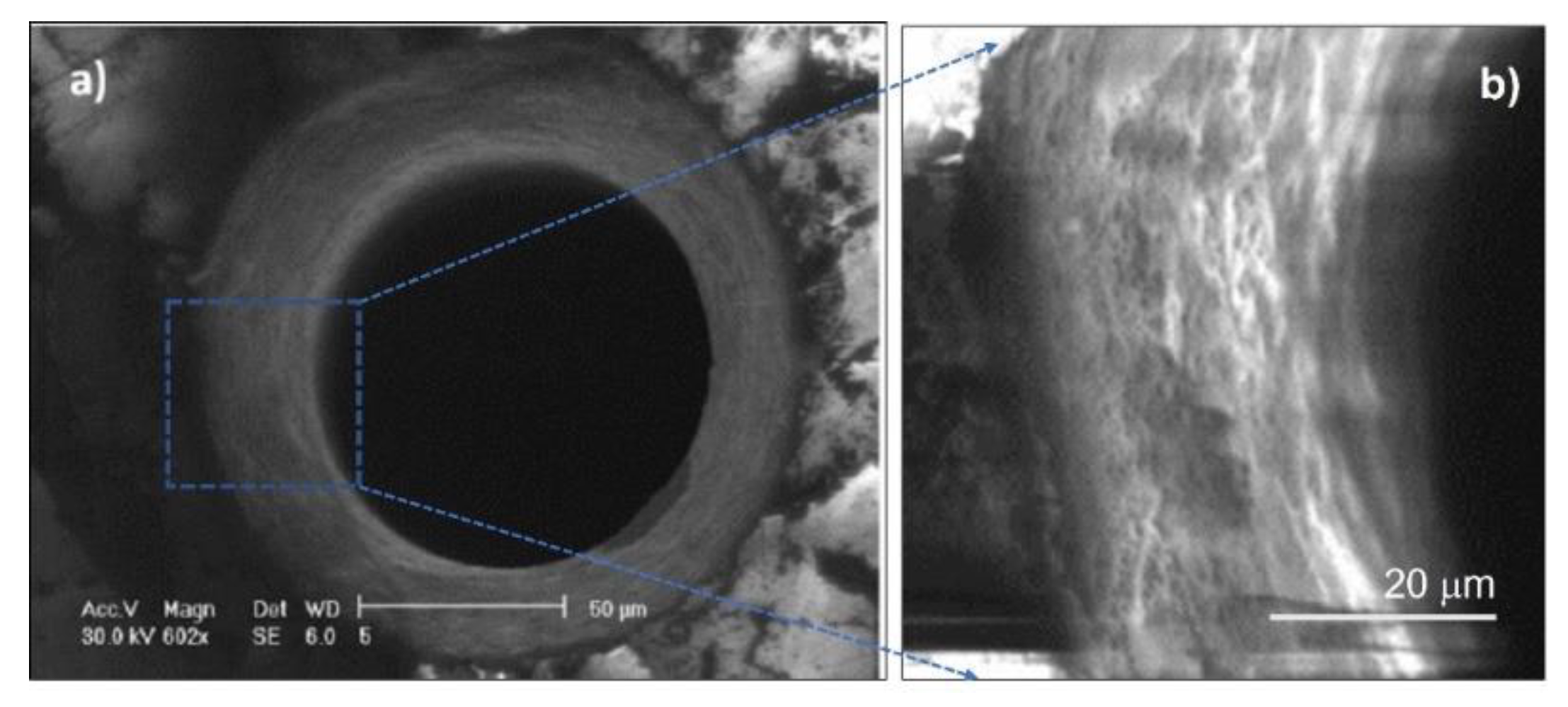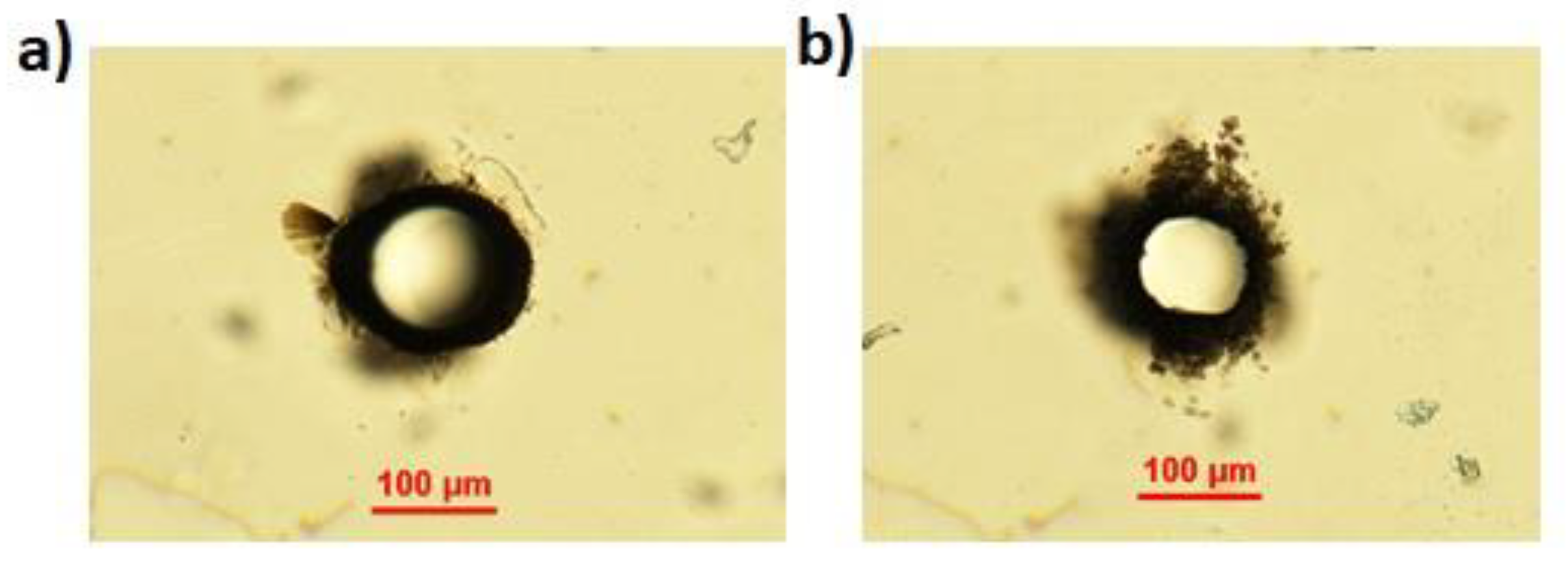Study of Through-Hole Micro-Drilling in Sapphire by Means of Pulsed Bessel Beams
Abstract
1. Introduction
2. Materials and Methods
2.1. Experimental Set-Up
2.2. Material Sample Details
2.3. Experimental Method
3. Results and Discussion
3.1. Single-Shot Bessel Beam Micromachining
3.2. Micro-Hole Drilling in Thick Sapphire Sample
3.2.1. Bessel Beam Trepanning Technique Applied to Sapphire
3.2.2. Removal and Reduction of Surface Cracks
3.2.3. Optimized Through-Holes in Sapphire
4. Conclusions
Author Contributions
Funding
Conflicts of Interest
References
- Katyba, M.; Zaytsev, K.I.; Dolganova, I.N.; Shikunova, I.A.; Chernomyrdin, N.V.; Yurchenko, S.O.; Komandin, G.A.; Reshetov, I.V.; Nesvizhevsky, V.V.; Kurlov, V.N. Sapphire shaped crystals for waveguiding, sensing and exposure applications. Prog. Cryst. Growth Charact. Mater. 2018, 64, 133–151. [Google Scholar] [CrossRef]
- Lee, J.; Hwang, S.; Kim, N.; Lee, J. InGaN-Based High-Power Flip-Chip LEDs with Deep-Hole-Patterned Sapphire Substrate by Laser Direct Beam Drilling. IEEE Electron Device Lett. 2010, 31, 698–700. [Google Scholar]
- Matsuo, S.; Shichijo, Y.; Tomita, T.; Hashimoto, S. Laser fabrication of ship-in-a-bottle microstructures in sapphire. J. Laser Micro Nanoeng. 2007, 2, 114–116. [Google Scholar] [CrossRef][Green Version]
- Lee, J.; Lee, D.; Oh, B.; Lee, J. Comparison of InGaN-Based LEDs Grown on Conventional Sapphire and Cone-Shape-Patterned Sapphire Substrate. IEEE Trans. Electron Devices 2010, 57, 157–163. [Google Scholar] [CrossRef]
- Sapphire Technology Market. Available online: https://www.marketsandmarkets.com/Market-Reports/sapphire-semiconductors-market-391455.html (accessed on 12 January 2022).
- Brand, J.L.; Tam, A.C. Mechanism of picosecond ultraviolet laser sputtering of sapphire at 266 nm. Appl. Phys. Lett. 1990, 56, 883–885. [Google Scholar] [CrossRef]
- Mishchik, K.; Gaudfrin, K.; Lopez, J. Drilling of through Holes in Sapphire Using Femtosecond Laser Pulses. J. Laser Micro Nanoeng. 2017, 12, 321–324. [Google Scholar]
- Pawar, P.; Ballav, R.; Kumar, A. Machining Processes of Sapphire: An Overview. Int. J. Mod. Manuf. Technol. 2017, 9, 47–72. [Google Scholar]
- Wang, X.C.; Lim, G.C.; Zheng, H.Y.; Ng, F.L.; Liu, W.; Chua, S.J. Femtosecond pulse laser ablation of sapphire in ambient air. Appl. Surf. Sci. 2004, 228, 221–226. [Google Scholar] [CrossRef]
- Chang, C.W.; Chen, C.Y.; Chang, T.L.; Ting, C.J.; Wang, C.P.; Chou, C.P. Sapphire surface patterning using femtosecond laser micromachining. Appl. Phys. A 2012, 109, 441–448. [Google Scholar] [CrossRef]
- Lott, G.; Falletto, N.; Devilder, P.J.; Kling, R. Optimizing the processing of sapphire with ultrashort laser pulses. J. Laser Appl. 2016, 28, 022206. [Google Scholar] [CrossRef]
- Ashkenasi, D.; Rosenfeld, A.; Varel, H.; Wähmer, M.; Campbell, E.E.B. Laser processing of sapphire with picosecond and sub-picosecond pulses. Appl. Surf. Sci. 1997, 120, 65–80. [Google Scholar] [CrossRef]
- Duocastella, M.; Arnold, C. Bessel and annular beams for materials processing. Laser Photonics Rev. 2012, 6, 607–621. [Google Scholar] [CrossRef]
- Durnin, J.; Miceli, J., Jr.; Eberly, J.H. Diffraction-free beams. Phys. Rev. Lett. 1987, 58, 1499–1501. [Google Scholar] [CrossRef] [PubMed]
- Durnin, J. Exact solutions for non-diffracting beams. 1. The scalar theory. J. Opt. Soc. Am. A 1987, 4, 651–654. [Google Scholar] [CrossRef]
- Bhuyan, M.K.; Courvoisier, F.; Lacourt, P.A.; Jacquot, M.; Salut, R.; Furfaro, L.; Dudley, J.M. High aspect ratio nanochannel machining using single shot femtosecond Bessel beams. Appl. Phys. Lett. 2010, 97, 081102. [Google Scholar] [CrossRef]
- Bhuyan, M.K.; Courvoisier, F.; Lacourt, P.-A.; Jacquot, M.; Furfaro, L.; Withford, M.J.; Dudley, J.M. High aspect ratio taper-free microchannel fabrication using femtosecond Bessel beams. Opt. Express 2010, 18, 566–574. [Google Scholar] [CrossRef]
- Liu, X.; Sanner, N.; Sentis, M.; Stoian, R.; Zhao, W.; Cheng, G.; Utéza, O. Front-surface fabrication of moderate aspect ratio micro-channels in fused silica by single picosecond Gaussian—Bessel laser pulse. Appl. Phys. A 2018, 124, 206. [Google Scholar] [CrossRef]
- Kumar, S.; Sotillo, B.; Chiappini, A.; Ramponi, R.; Eaton, S.M.; Jedrkiewicz, O. Study of graphitic microstructure formation in diamond bulk by pulsed Bessel beam laser writing. Appl. Phys. A 2017, 123, 698. [Google Scholar] [CrossRef]
- Garzillo, V.; Jukna, V.; Couairon, A.; Grigutis, R.; Di Trapani, P.; Jedrkiewicz, O. Optimization of laser energy deposition for single-shot high aspect-ratio microstructuring of thick BK7 glass. J. Appl. Phys. 2016, 120, 013102. [Google Scholar] [CrossRef]
- Jedrkiewicz, O.; Kumar, S.; Sotillo, B.; Bollani, M.; Chiappini, A.; Ferrari, M.; Ramponi, R.; Di Trapani, P.; Eaton, S.M. Pulsed Bessel beam-induced microchannels on a diamond surface for versatile microfluidic and sensing applications. Opt. Mater. Express 2017, 7, 1962–1970. [Google Scholar] [CrossRef]
- Stoian, R.; Bhuyan, M.K.; Zhang, G.; Cheng, G.; Meyer, R.; Courvoisier, F. Ultrafast Bessel beams: Advanced tools for laser materials processing. Adv. Opt. Technol. 2018, 7, 165–174. [Google Scholar] [CrossRef]
- Dudutis, J.; Stonys, R.; Račiukaitis, G.; Gečys, P. Glass dicing with elliptical Bessel beam. Opt. Laser Technol. 2019, 111, 331–337. [Google Scholar] [CrossRef]
- Bhuyan, M.; Jedrkiewicz, O.; Recchia, S.; Apprea, A.; Masciocchi, N.; Bollani, M.; Di Trapani, P. High speed cutting of strong transparent materials using picosecond Bessel beams. Appl. Phys. A 2015, 120, 443–446. [Google Scholar] [CrossRef]
- Rapp, L.; Meyer, R.; Furfaro, L.; Billet, C.; Giust, R.; Courvoisier, F. High speed cleaving of crystals with ultrafast Bessel beams. Opt. Express 2017, 25, 9312–9317. [Google Scholar] [CrossRef] [PubMed]
- Jenne, M.; Flamm, D.; Ouaj, T.; Hellstern, J.; Kleiner, J.; Grossmann, D.; Koschig, M.; Kaiser, M.; Kumkar, M.; Nolte, S. High-quality tailored-edge cleaving using aberration-corrected Bessel-like beams. Opt. Lett. 2018, 43, 3164–3167. [Google Scholar] [CrossRef] [PubMed]
- Zhang, G.; Stoian, R.; Zhao, W.; Cheng, G. Femtosecond laser Bessel beam welding of transparent to non-transparent materials with large focal-position tolerant zone. Opt. Express 2018, 26, 917–926. [Google Scholar] [CrossRef] [PubMed]
- Jedrkiewicz, O.; Valetti, D.; Di Trapani, P. Etching and drilling of through-holes in thin glass by means of picosecond Bessel beams. SN Appl. Sci. 2019, 1, 1267. [Google Scholar] [CrossRef]
- Belloni, V.V.; Bollani, M.; Eaton, S.M.; Di Trapani, P.; Jedrkiewicz, O. Micro-Hole Generation by High-Energy Pulsed Bessel Beams in Different Transparent Materials. Micromachines 2021, 12, 455. [Google Scholar] [CrossRef]
- Liu, T.; Wei, H.; Wu, J.; Lu, J.; Zhang, Y. Modulation of crack formation inside single-crystal sapphire using ultrafast laser Bessel beams. Opt. Laser Technol. 2021, 136, 106778. [Google Scholar] [CrossRef]
- Gedvilas, M.; Račiukaitis, G. Spatial zigzag evolution of cracks in moving sapphire initiated by bursts of picosecond laser pulses for ultrafast wafer dicing. RSC Adv. 2020, 10, 33213–33220. [Google Scholar] [CrossRef]
- Rapp, L.; Meyer, R.; Giust, R.; Furfaro, L.; Jacquot, M.; Lacourt, P.A.; Dudley, J.M.; Courvoisier, F. High aspect ratio micro-explosions in the bulk of sapphire generated by femtosecond Bessel beams. Sci. Rep. 2016, 6, 34286. [Google Scholar] [CrossRef] [PubMed]
- Crisp, M.D.; Boling, N.L.; Dubé, G. Importance of Fresnel reflections in laser surface damage of transparent dielectrics. Appl. Phys. Lett. 1972, 21, 364–366. [Google Scholar] [CrossRef]
- Dopbrovinskaya, E.R.; Lytvynov, L.A.; Pishchik, V. Sapphire: Material, Manufacturing, Applications, 1st ed.; Springer: New York, NY, USA, 2009. [Google Scholar]
- Sapphire Properties. Available online: http://www.roditi.com/SingleCrystal/Sapphire/Properties.html (accessed on 15 February 2022).
- Thermal Properties of Sapphire. Available online: https://www.shinkosha.com/english/techinfo/feature/thermal-properties-of-sapphire/ (accessed on 15 February 2022).
- Sapphire Technical Specification. Available online: https://www.industrialjewels.com/sapphire-technical-specification/ (accessed on 15 February 2022).
- Durnin, J.; Miceli, J.J.; Eberly, J.H. Comparison of Bessel and Gaussian beam. Opt. Lett. 1988, 13, 79–80. [Google Scholar] [CrossRef] [PubMed]









| Physical and Chemical Properties of Sapphire | |
|---|---|
| Refractive index | 1.77 |
| Hardness (on Mohs scale) | 9 |
| Density (kg/m3) | 3.98 × 103 |
| CTE (10−6 K−1) | 5.5 |
| Young modulus Y (GPa) | 345 |
| Melting temperature (°C) | 2040 |
| Thermal Conductivity (W/m·K) | 23–25 |
| Transmission range (μm) | 8.4 |
| Softening Temperature (°C) | 1797 |
| Parameters | Present Work | Reference [7] | Reference [11] |
|---|---|---|---|
| Material | Monocrystalline Sapphire (c-cut) | Monocrystalline Sapphire (c-cut) | Monocrystalline Sapphire (c-cut) |
| Beam | Bessel | Gaussian | Gaussian |
| Pulse duration | Picosecond (6 ps) | Femtosecond (300–500 fs) | Picosecond (0.8 ps) |
| Sample thickness | 430 μm | 300 μm | 430 μm |
| Hole diameter | ≈100 μm | ≈1 mm | ≈400 μm |
| Machining technique | Trepanning with Kapton Polyimide Tape | Bottom—Up Ablation with Spiraling | Bottom—Up Ablation with Spiraling |
| Tapering angle | <5° | <3° | <2°–<5° |
| Z-axis translation | No | Yes | Yes |
Publisher’s Note: MDPI stays neutral with regard to jurisdictional claims in published maps and institutional affiliations. |
© 2022 by the authors. Licensee MDPI, Basel, Switzerland. This article is an open access article distributed under the terms and conditions of the Creative Commons Attribution (CC BY) license (https://creativecommons.org/licenses/by/4.0/).
Share and Cite
Kuriakose, A.; Bollani, M.; Di Trapani, P.; Jedrkiewicz, O. Study of Through-Hole Micro-Drilling in Sapphire by Means of Pulsed Bessel Beams. Micromachines 2022, 13, 624. https://doi.org/10.3390/mi13040624
Kuriakose A, Bollani M, Di Trapani P, Jedrkiewicz O. Study of Through-Hole Micro-Drilling in Sapphire by Means of Pulsed Bessel Beams. Micromachines. 2022; 13(4):624. https://doi.org/10.3390/mi13040624
Chicago/Turabian StyleKuriakose, Akhil, Monica Bollani, Paolo Di Trapani, and Ottavia Jedrkiewicz. 2022. "Study of Through-Hole Micro-Drilling in Sapphire by Means of Pulsed Bessel Beams" Micromachines 13, no. 4: 624. https://doi.org/10.3390/mi13040624
APA StyleKuriakose, A., Bollani, M., Di Trapani, P., & Jedrkiewicz, O. (2022). Study of Through-Hole Micro-Drilling in Sapphire by Means of Pulsed Bessel Beams. Micromachines, 13(4), 624. https://doi.org/10.3390/mi13040624








